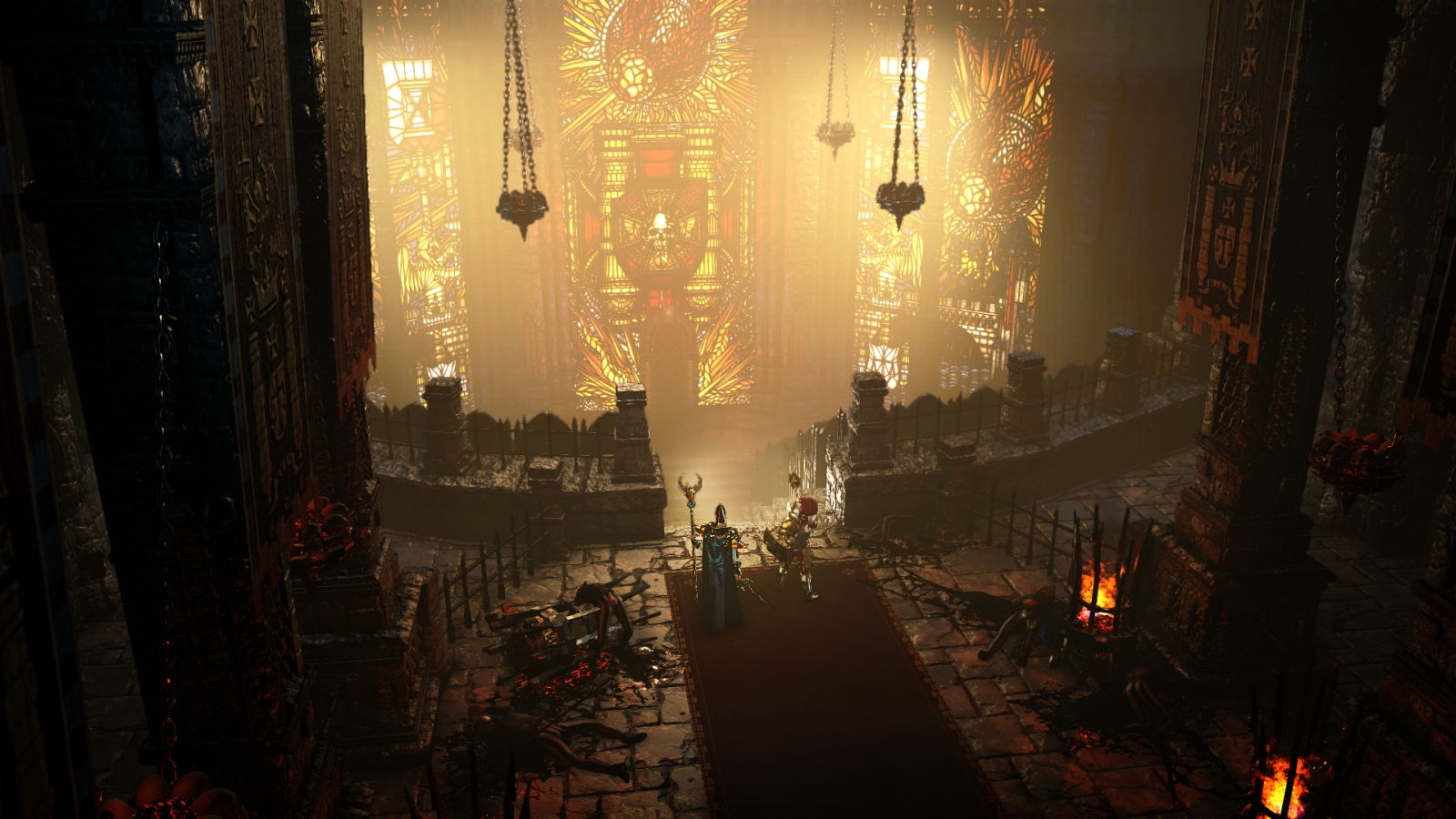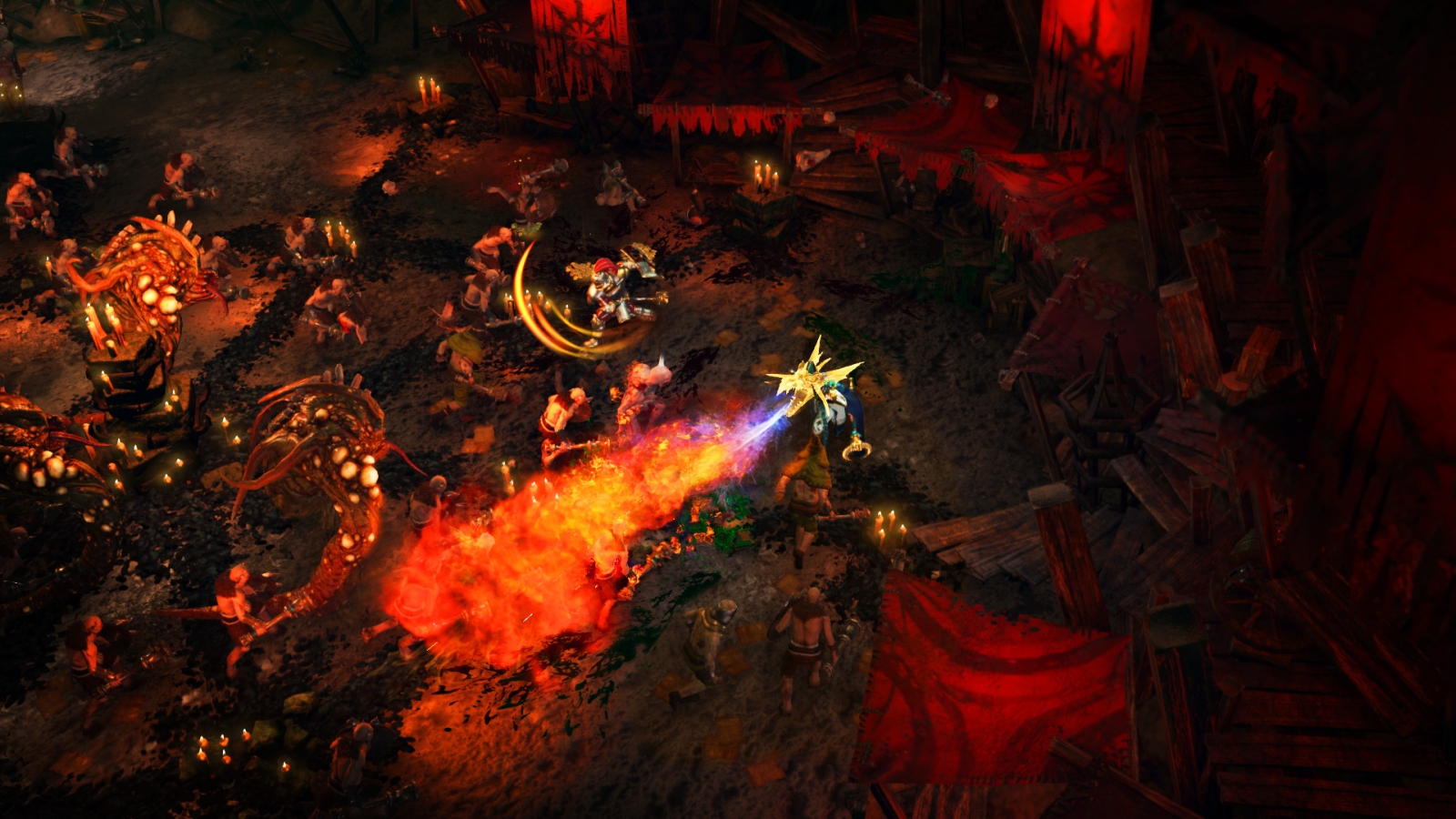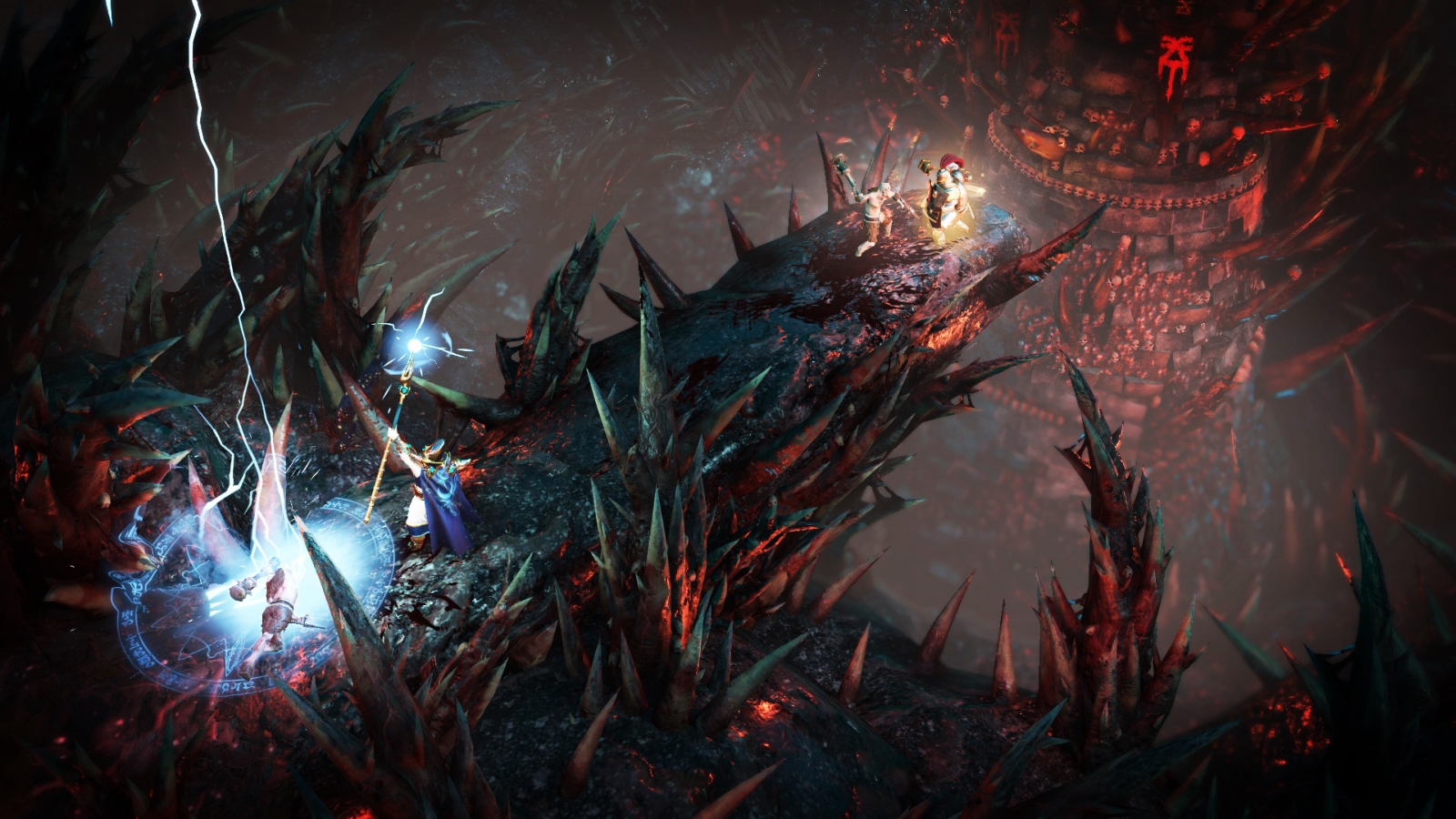
Games Workshop and developer Eko Software have teamed up to deliver something new to the Warhammer universe — an Action RPG. To do this, the studios clearly cast an eye to a few of the folks that have done it right, took a few pages from their books, and set to worldbuilding around it. Enter Warhammer: Chaosbane. With one heaping portion of Diablo III, a pinch of Path of Exile, a grip of Gauntlet, and a dash of Champions of Norrath thrown in for good measure, the game takes the best parts of these four games and combines them with a few new tricks to deliver something different and more than the sum of its parts. It’s time to team up with three friends and see what makes Warhammer: Chaosbane unique.
To kick things off, there is a great deal of exposition in Chaosbane, providing some backstory on the worldbuilding necessary to make you care about your adventure. Whether you are new to Warhammer or you are a returning fan, you’ll want to pay attention to the lengthy introduction as it’ll provide a bit of backstory on the major characters and their foes. That said Warhammer: Chaosbane can be a real steep climb for the non-devotee. If you are coming into this new, you’ll wonder why anyone would name a baddie “Nurgle” or just what the hell is going on half the time, but places like Norska are pretty gorgeous, whether you have any idea why it’s important to the lore or not. Settle in for the high fantasy, and try not to roll your eyes at the semi-Shakespearean prattle.
With the intro out of the way, you’ll select from one of the four heroes available at launch. Imperial Soldier Konrad Vollen the Scarred is your frontline combat specialist, able to wield a sword and shield. High-elf Mage Prince Elontir is your caster class, capable of delivering magical pain. Bragi Axebiter is a Slayer, which is to say “axe wielding berserker”. Elessa is a young Wood Elf archer tackling foes from a distance with her bow, as well as handling crowd control and summoning. Suspiciously absent is a Witch Hunter class, but more on that in a minute.
It’s at this point that you might see where Warhammer: Chaosbane has picked up a problem from the Diablo II days — static heroes. If you planned to play a female dwarf, or a male scout, you are out of luck — the four characters are locked in, all the way down to their name. You can customize their skills, and their equipment will drastically alter their appearance, but you are stuck with their names and sex. That said, it’s their skills that ultimately deliver the most differentiation.
After about an hour, you’ll have unlocked several skill options for your selected character as well as a few unique mechanics. As an example, Elontir can throw down an orb that he can “steer” into enemies, whereas Vollen can stun foes using a powerful shield bash. Bragi stacks up rage that helps him regenerate the longer he stays engaged with enemies and can throw an axe on a chain to close distance quickly, and Elessa is able to roll-dodge away from her foes. Elessa has a fairy that follows her around and when she touches it, the energy she uses for her bow skills are restored. These special attack mechanics enable the heroes to regenerate the ‘fuel’ for their abilities, since there are no mana/rage/angry potions.
Since this is an ARPG, the subject of gear is obviously of great importance, and there’s plenty of loot in Chaosbane to keep you busy. While Eko Software should have their hands smacked with a ruler for changing the progression color scheme that’s been drilled into us for decades (grey, green, blue, gold), opting for their own path from vendor trash to Heroic items, there’s certainly a great deal of it. Set pieces are common, even in the earlier parts of the game. The stats are the type you’d expect, granting extra critical hit chance, increasing health or magic, providing additional damage, or an increase to overall armor, just to name a few. Later in the game there are a few wobbles in stats and balance, but ultimately this is something every ARPG suffers from at launch.
Beyond the skill tree which is fairly expansive, there is also a “God Tree” that provides another arc of customization. This secondary skill tree immediately reminded me of the Sphere Grid from Final Fantasy X. Given multiple paths, you’ll spend your hard-earned fragments to reach additional health, armor, mana, etc. and ultimately new skills that can be folded into your repertoire. If all of this sounds like an overwhelming amount of choice, you’ll really enjoy the one feature that makes Chaosbane unique.
Most RPGs of any kind push the player to choose a path and stick with it. If you want to be a DPS character, you’ll figure out the path that helps you do that. If you want to be a healer, that’s a whole different path. Chaosbane lets you fluidly switch at will. You’ll have a certain amount of skill points earned at level up, and each skill you select has an associated “cost” to it. As every skill is unlocked once you pass the level required (other than the aforementioned God Tree ones), you’ll instead spend those skill points to “activate” it, with higher tiers of those powers costing more points. If you find that you don’t like that skill, or you’d like to respec to tackle a specific enemy or boss, you simply deactivate that power and all of those points are refunded for you to apply elsewhere. As each character has powers that generate power or spend it, it’s up to you to balance your character’s powers.
In practice, the skill variants aren’t as deep as the numbers might suggest. There are a handful of skills, and minor variants within each, so the outcomes aren’t quite as revolutionary as they seem on the surface. The good news is that it’s enough to get the job done, but if you are thinking this ARPG has the depth of, say, an MMO, you might be expecting too much.
There is one unique power-up common to all four characters in Chaosbane. As you mow down the endless parade of baddies, occasionally they’ll cough up a red glowing orb. Picking these up doesn’t restore health as every game before this has trained us, but instead powers up your character’s super attack. When full, you can launch into an assault that unleashes a ton of damage while making your character nearly impossible to kill for a short while. It breaks up the hack and slash with an overpowered hack and slash.
Warhammer: Chaosbane is available on Xbox One, PlayStation 4, and PC. Bafflingly, there are almost no optimization options on the latter platform. You cannot bump your framerate to 60+ to take advantage of your shiny and expensive video card, adjust anti-aliasing, or really do anything other than set your resolution and tick a box for VSync, and adjust basics like HUD size and brightness. Where are my advanced options to really push the game to take advantage of my high-end hardware? In this way, it feels very much tethered to the “basic PC port” chain.
I am very happy to report that the game supports four player cooperative play, and you are free to mix and match between local and online players. Although, it would be nice to allow players to customize their characters to differentiate them beyond the markers above their heads, especially when two people decide to pick Elontir.
If you are watching my videos and see that I’m playing with a controller, you’ll be happy to know that the game is equally as viable on a keyboard. Steering is handled with the mouse and you click where you’d like to move. Space bar unleashes your character’s special (dodge, steering your spells, shield bash, or fling out a grappling axe as appropriate), and your number keys 1-4 pop your selected power. It’s reminiscent of Diablo III and it works, so I can see why Eko chose not to mess with a good thing.
The four acts in the game are punctuated (as you might expect) by a large Chaos boss that’ll take a little more of a beating before spraying you with that sweet, sweet loot. What’s strange here is that you don’t actually use the money you pick up or loot you don’t need. Instead, you hand over your loot to the local Collector’s Guild in exchange for favor and prestige. These reputation levels are shared across your characters, which is handy for collecting higher tier rewards more quickly when ramping up a new toon, but the lack of an in-game economy is a little odd. Without a vendor to purchase things, you’ll only be using all that picked up coin to upgrade God Tier stats.
I do have a bit of a complaint with the randomization elements and mission design in Warhammer: Chaosbane. By way of example, you’ll pop in to see Teclis, go into the sewers, hack up some baddies, come back up and talk to Teclis, go right back down into the same sewers and go slightly further before coming back to talk to Teclis again. You’ll start to see the repetition of randomization ‘tiles’ (“oh, this is the T-shaped room, on that’s the H shaped one, and here comes the circular mini-boss room”), and while you might encounter them in random order and attachment, it does wipe away some of the surprise of a new area. The second, third, and fourth act follow this same pattern. Add in the fact that there doesn’t seem to be a waypointing system, and it makes for a bit more repetition than I’d like.
There are a few bugs left to squash in Chaosbane, like the occasional crash to desktop, one hitch where a quest trigger wouldn’t activate to let us finish a mission (we ended up having to do it in solo play and then rejoin our multiplayer band to continue), and an eyebrow-raising few moments where Elessa’s voice suddenly got a lot more male all of a sudden. I also ran into issues going up and down stairs where spells or arrows would impact the stair surface instead of plunging into the chests of the enemy.
My biggest axe to grind comes from the matchmaking system, or lack thereof. If you are using a controller, you’ll have to pick up the keyboard to use Steam’s matchmaking system to accept or send invites – there is no controller path to accept or send. Similarly, matchmaking is haphazard, pairing you with players who can be wildly disconnected from your current level or story progression. Nobody has ever swooned over the amazing matchmaking system Steam has delivered, so it’s unclear why Eko chose this path.
For any good ARPG to have longevity there has to be a solid endgame to keep pulling you back in. Once you complete a chapter of the main game (all in, somewhere around the 14 hours in total), there is an Expedition Mode that lets you farm randomly generated maps for better gear and the fragments needed to upgrade it, and a Relic Hunt, which feels the same as Expedition mode, but with modifiers thrown in. There is also a “Boss rush mode” that lets you re-engage the four big baddies at the end of each chapter. Beyond that, there are 10 difficulty levels from Very Easy to Chaos 5, each offering an increase in the loot quality, gold drop, and fragments you’ll receive. DLC is on the horizon, and perhaps that’ll bring us new classes like the Witch Hunter, Bright Wizard, Warrior Priest, Knight of the Blazing Sun, Engineer, or any of the dozens of other classes in this rich universe. We could also use some quality of life improvements like loot trading between players, better matchmaking, and something to do with our XP after level 50. Time will tell, but here is an Endgame and Post-Launch update from the team:
In practice, Warhammer: Chaosbane has more in common with Diablo II than Diablo III, and all of the highs and lows that implies. There are the makings of a solid ARPG here and a lot of fun to be had, but so much of the game clocks in as ‘average’. I’m hopeful that Warhammer: Chaosbane will go through the same improvement arc that makes Diablo III as successful as it is today.
Warhammer: Chaosbane
Good
Warhammer: Chaosbane is a solid first entry into the ARPG genre for the franchise. There are some cool twists on the theme like the God Tier system, but there are equally as many baffling decisions such as the matchmaking system, lack of economy, and decidedly absent customization options. There are the makings of a solid ARPG in here, but it needs a little more time in the oven to bake.
Pros
- 4 player drop-in/out couch and online cooperative
- God Tier system is a cool twist
- Good looking game across the board
- Solid replayability
- Four character classes to play (so far)
Cons
- Pattern repetition across the four acts
- Skill system isn’t as deep as hoped
- Lack of economic functions like trade or buy/sell
- No customization at all




